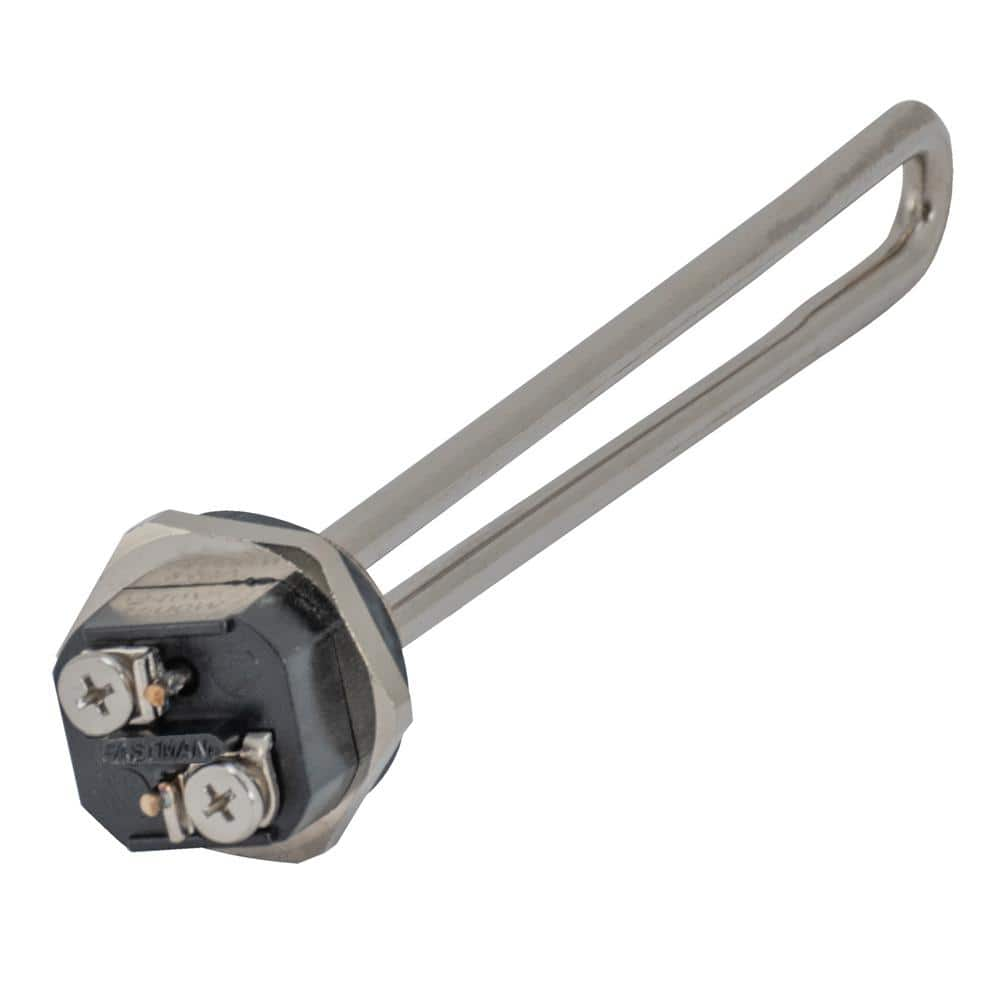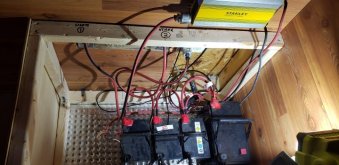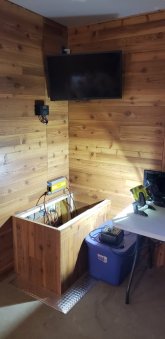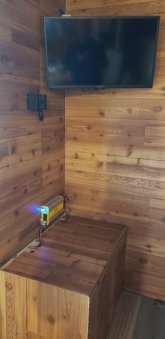You are using an out of date browser. It may not display this or other websites correctly.
You should upgrade or use an alternative browser.
You should upgrade or use an alternative browser.
Battery Bank - AGM
- Thread starter HARG Hunter
- Start date
GSXR1000
Solar Enthusiast
- Joined
- Nov 20, 2020
- Messages
- 865

Just ordered Lifepo4 prismatic cell 3.2V 280Ah lithium lifepo4
Shenzhen Basen Technology Co., Ltd. off of Alibaba.. ordered 8 cells for 2x12V for 460AH hope everything goes smooth
HARG Hunter
Thirsty for Off-Grid Knowledge
Glad to see that 14.5v
HARG Hunter
Thirsty for Off-Grid Knowledge
FINALLY feel like my set up is good.
Just got done rewiring EVERYTHING.
Went 2ga battery-to-battery. 6ga inverter to battery. Separated the + and - to the Rover to balance things. I have the water pump wired DC to a battery in the middle. Separated the + and - to the Inverter as well. Should be good to go.
After I hooked it all back up to the panels I turned on everything. It was drawing 300 watts and it only dropped to 12.7v. It didn't take long for it to get back into 13.5 rage without a load and now 10 minutes later it's back up to 14.5v.
Thanks for the help!
I've attached pics of my set up.
Just got done rewiring EVERYTHING.
Went 2ga battery-to-battery. 6ga inverter to battery. Separated the + and - to the Rover to balance things. I have the water pump wired DC to a battery in the middle. Separated the + and - to the Inverter as well. Should be good to go.
After I hooked it all back up to the panels I turned on everything. It was drawing 300 watts and it only dropped to 12.7v. It didn't take long for it to get back into 13.5 rage without a load and now 10 minutes later it's back up to 14.5v.
Thanks for the help!
I've attached pics of my set up.
Attachments
Bob142
Build more, learn more.
Awesome. Each time I do that on something I figure it's for the last time. Then it isn't. Hopefully you'll be good to go for a long while now.Just got done rewiring EVERYTHING.
I didn't follow this part. Do you mean you don't have all your charge and load + and - connections to the same terminals on your battery bank?I have the water pump wired DC to a battery in the middle.
Hedges
I See Electromagnetic Fields!
- Joined
- Mar 28, 2020
- Messages
- 20,505
I see a picture of 4 batteries (two different sizes) in parallel.
So it doesn't matter where a small load like water pump is connected.
(Not like series connected, where a lower voltage load connected to one battery would cause different state of charge between batteries/cells.)
So it doesn't matter where a small load like water pump is connected.
(Not like series connected, where a lower voltage load connected to one battery would cause different state of charge between batteries/cells.)
Bob142
Build more, learn more.
I was just curious what the motivation was to do it that way. It wouldn't have been something that even crossed my mind. Doesn't seem to follow best practice if you're trying to have the batteries wear evenly, but since we're dealing with the mismatched bank I suppose it's moot.
HARG Hunter
Thirsty for Off-Grid Knowledge
I understood this to be the same. This is 1 parallel battery bank but I have the inverter and cc connected at the end of the bank so keep it balanced, then the DC pump to the same battery. I don't believe it would matter with my setup.
We will see how it goes.
We will see how it goes.
HARG Hunter
Thirsty for Off-Grid Knowledge
System worked great this weekend.
Tuesday and Wednesday were mostly cloudy, but the bank jumped up to 13.6 each day.
Was able to run the TV, lights, charge my phone and laptop, the DC Water Pump and even a ceiling fan through the night. Lowest it went down to was 12.1 and that was in the morning after the ceiling fan was running all night.
I think the combination of me re-wiring the bank and the inverter with heavier cable, plus changing connections to the ends to balance out the bank did the trick.
I do think adding 1 more panel (Wire the 4 of them 2s2p) and adding 1 more 100ah battery and this system will give me everything I need outside of running some crazy stuff like a Window AC unit etc...
Last thing will be adding a Pure Sine Wave Inverter.
I am currently using a 1000W Mod Sine.
Tuesday and Wednesday were mostly cloudy, but the bank jumped up to 13.6 each day.
Was able to run the TV, lights, charge my phone and laptop, the DC Water Pump and even a ceiling fan through the night. Lowest it went down to was 12.1 and that was in the morning after the ceiling fan was running all night.
I think the combination of me re-wiring the bank and the inverter with heavier cable, plus changing connections to the ends to balance out the bank did the trick.
I do think adding 1 more panel (Wire the 4 of them 2s2p) and adding 1 more 100ah battery and this system will give me everything I need outside of running some crazy stuff like a Window AC unit etc...
Last thing will be adding a Pure Sine Wave Inverter.
I am currently using a 1000W Mod Sine.
NICE!
Hopefully, you witnessed a foray into the 14.XV range again, though it can be easy to miss if you're not trying to catch it.
Ceiling fans are off-grid banes. They use a lot of energy. They're particularly bad because everyone thinks, "hey, these things save energy," so they don't turn them off when not in use. A typical ceiling fan on medium can consume over 50% of your 190Ah capacity in 24 hours. 12.1V under a low load is getting close to the 50% threshold.
400W/12V = 33.3A peak
33.3A peak is a good charge current for 222 (15% charge current) to 333Ah (10% charge current) of batteries, so going for 290Ah is good if you get the 4th panel.
Hopefully, you witnessed a foray into the 14.XV range again, though it can be easy to miss if you're not trying to catch it.
Ceiling fans are off-grid banes. They use a lot of energy. They're particularly bad because everyone thinks, "hey, these things save energy," so they don't turn them off when not in use. A typical ceiling fan on medium can consume over 50% of your 190Ah capacity in 24 hours. 12.1V under a low load is getting close to the 50% threshold.
400W/12V = 33.3A peak
33.3A peak is a good charge current for 222 (15% charge current) to 333Ah (10% charge current) of batteries, so going for 290Ah is good if you get the 4th panel.
HARG Hunter
Thirsty for Off-Grid Knowledge
I checked on it constantly as I was installing flooring in the living area. At one point when the sun jumped out from behind the clouds it peaked at 13.8 but never got back to the 14.x range. It was super cloudy all day both days though, so when I had it down to 12.3 the first morning after it hit 14.5, I was happy with it. Then each day it got back to 13.4 or 13.5 despite not much sun.NICE!
Hopefully, you witnessed a foray into the 14.XV range again, though it can be easy to miss if you're not trying to catch it.
Ceiling fans are off-grid banes. They use a lot of energy. They're particularly bad because everyone thinks, "hey, these things save energy," so they don't turn them off when not in use. A typical ceiling fan on medium can consume over 50% of your 190Ah capacity in 24 hours. 12.1V under a low load is getting close to the 50% threshold.
400W/12V = 33.3A peak
33.3A peak is a good charge current for 222 (15% charge current) to 333Ah (10% charge current) of batteries, so going for 290Ah is good if you get the 4th panel.
As with all of my lighting and appliances, I did a ton of research on the ceiling fans before I bought them, and this ceiling fan only draws about 35w on it's low setting, and I only run it at night to circulate the heated air from our furnace. We conserve heavily and only keep lights on or run things when they are needed. I've got the rest of the guys in our hunting camp trained.
I've given up on running the coffee maker until I add the 4th panel and another battery, plus get a Pure Sine Inverter.
I just fire up the generator in the morning and run the coffee maker on that so I don't shorten the life of the batteries.
Outside of that, we only have 2 ceiling fans, 7 LED lights (5w-7w range each), 32" LED TV (35w), then outlets for charging phones and laptops. I believe this system is very close to being able to handle all of this without any problems now even when we don't ideal solar conditions.
At least now you're confident you're getting to 14.XV on a sunny day. 13.X is well short of fully charged, but they're in the healthy zone in terms of being charged enough to prevent damage.
Sounds like you're pretty much there, particularly with the additional equipment. Regardless of how much or how little sun you get, you're increasing your available daily energy use by 33%, and you're increasing your no-sun run-time by 50%.
Personally, given the low frequency of use, the type of stuff you're powering, and the cost, I'd put the PSW inverter off unless you find the inverter is actually unable to run the coffee maker... just long enough to run the brew cycle... not to keep it hot...
Sounds like you're pretty much there, particularly with the additional equipment. Regardless of how much or how little sun you get, you're increasing your available daily energy use by 33%, and you're increasing your no-sun run-time by 50%.
Personally, given the low frequency of use, the type of stuff you're powering, and the cost, I'd put the PSW inverter off unless you find the inverter is actually unable to run the coffee maker... just long enough to run the brew cycle... not to keep it hot...
HARG Hunter
Thirsty for Off-Grid Knowledge
The coffee maker peaks at 895w. The Inverter is 1000w, and even when nothing else is drawing, the inverter shuts off when I run the coffee maker. It only takes 9 minutes to brew, and I always turn it off after brewing and keep the coffee hot on the furnace.Personally, given the low frequency of use, the type of stuff you're powering, and the cost, I'd put the PSW inverter off unless you find the inverter is actually unable to run the coffee maker... just long enough to run the brew cycle... not to keep it hot...
At the same time, I'm not sure I really looked at the bank at the time so it might have been low.
Next time the bank is in the 14.5v range I will give it a shot again.
The problem I foresee is that we'll almost always be running the coffee maker in the morning, and that will almost always be when the bank is at it's lowest charge. It's not the end of the world. We have a Coleman stove top coffee maker, so the electric one was just a luxury. At the same time, if I can make that work, it'll put this over the top as far as a success goes.
Our cabin is literally a half mile away from the nearest power line, so this system is a total victory for us.
Right now I've got about $1000 into it, and I plan on another $500 or so, and we'll be good to go.
Hedges
I See Electromagnetic Fields!
- Joined
- Mar 28, 2020
- Messages
- 20,505
In the summer when battery gets full charged, a dump load to make use of excess power could be operated, for instance a water heater.
Here's a 240V 1500W element, which should draw about 400W at 120VAC

Need some sort of control with hysteresis to enable it at appropriate times.
Here's a 240V 1500W element, which should draw about 400W at 120VAC

EASTMAN 7-1/2 in. 240-Volt x 1500-Watt Straight Water Heater Element - Normal Duty 60054 - The Home Depot
The Eastman Straight Water Heater Element has a high watt density and has a wattage and voltage of 240V x 1500W and has an 9-inch minimum tank diameter. It features a screw mount with gasket and is coated
www.homedepot.com
Need some sort of control with hysteresis to enable it at appropriate times.
The coffee maker peaks at 895w. The Inverter is 1000w, and even when nothing else is drawing, the inverter shuts off when I run the coffee maker. It only takes 9 minutes to brew, and I always turn it off after brewing and keep the coffee hot on the furnace.
At the same time, I'm not sure I really looked at the bank at the time so it might have been low.
Next time the bank is in the 14.5v range I will give it a shot again.
The problem I foresee is that we'll almost always be running the coffee maker in the morning, and that will almost always be when the bank is at it's lowest charge. It's not the end of the world. We have a Coleman stove top coffee maker, so the electric one was just a luxury. At the same time, if I can make that work, it'll put this over the top as far as a success goes.
Our cabin is literally a half mile away from the nearest power line, so this system is a total victory for us.
Right now I've got about $1000 into it, and I plan on another $500 or so, and we'll be good to go.
If that's the case, a PSW might suffer the same fate. You upping your cable gauge recently will help a lot if that was the case. I'd definitely wait to try it on a day you KNOW you got to full charge the day prior and keep an eye on the voltage.
Lastly, I've probably mentioned it, but I've lost track. Even with the batteries indoors, when cold, they probably aren't being optimally charged unless you have voltage compensation active. If you have a temp sensor on your battery with compensation active. Stop reading. When it's 77°F or so, all the default numbers apply, but when its colder, charging voltage INcreases by 0.03V per 1°C, so if the batteries are at freezing the day before you get there, the charge voltage shouldn't be 14.5V, it should be 15.25V. If it's only charged to 14.5V at freezing, you might be leaving 10% on the table after a good day of sun, which means you might be starting with a lower charge when you arrive in the evening. Most chargers support this with a temperature probe.
HARG Hunter
Thirsty for Off-Grid Knowledge
I've been watching things a lot closer now, so I will have to keep that going and test the limits.If that's the case, a PSW might suffer the same fate. You upping your cable gauge recently will help a lot if that was the case. I'd definitely wait to try it on a day you KNOW you got to full charge the day prior and keep an eye on the voltage.
Lastly, I've probably mentioned it, but I've lost track. Even with the batteries indoors, when cold, they probably aren't being optimally charged unless you have voltage compensation active. If you have a temp sensor on your battery with compensation active. Stop reading. When it's 77°F or so, all the default numbers apply, but when its colder, charging voltage INcreases by 0.03V per 1°C, so if the batteries are at freezing the day before you get there, the charge voltage shouldn't be 14.5V, it should be 15.25V. If it's only charged to 14.5V at freezing, you might be leaving 10% on the table after a good day of sun, which means you might be starting with a lower charge when you arrive in the evening. Most chargers support this with a temperature probe.
This past week has been a really big learning curve for me. A lot of things clicked. Now that I have a good grasp of things, I can start tweaking things bit by bit. I really appreciate the help from everyone here.
I do have a temp probe on the Rover Elite. The Rover is almost always reading 25 or 26 (c) for a temp.
Like you said, the majority of the time I get there for the weekend, the cabin is cold (usually around 35(f)) so not quite freezing, but I heat it up to 60 quickly.
The problem with me only being there every other weekend or so is it's hit and miss with the weather.
In January I will have a much more flexible schedule, so I'm going to try and make it there when I know we have a stretch of sunny weather.
HARG Hunter
Thirsty for Off-Grid Knowledge
Made a quick drive to the cabin today to plow the snow from this last storm.NICE!
Hopefully, you witnessed a foray into the 14.XV range again, though it can be easy to miss if you're not trying to catch it.
I was pleasantly surprised to see the bank at 14.5v and 12.4 kwh when I got there.
Things are looking good!
HARG Hunter
Thirsty for Off-Grid Knowledge
It's been a while since I've posted because fortunately things have been running great.
It is that time of year when it's consistently cloudy and we've been draining the battery bank down quite a bit.
I'm looking at picking up a battery charger to run off of the generator when it gets low and I need to bring back up to a full charge.
Just looking at a simple battery charger probably a 20 Amp. Is there a brand that anyone loves or conversely a brand I should stay away from?
Been looking at Schumacher. Seems to get decent reviews. The Viking from Harbor Freight and a few others. Just looking for feedback.
Thanks in Advance!
It is that time of year when it's consistently cloudy and we've been draining the battery bank down quite a bit.
I'm looking at picking up a battery charger to run off of the generator when it gets low and I need to bring back up to a full charge.
Just looking at a simple battery charger probably a 20 Amp. Is there a brand that anyone loves or conversely a brand I should stay away from?
Been looking at Schumacher. Seems to get decent reviews. The Viking from Harbor Freight and a few others. Just looking for feedback.
Thanks in Advance!
Hedges
I See Electromagnetic Fields!
- Joined
- Mar 28, 2020
- Messages
- 20,505
I do use the HF Viking 4A charger and am happy with it.
It doesn't have temperature compensation, but does have manual "*AGM" vs. "AGM" to indicate a colder setting.
What it doesn't provide is a higher setting for equalization. That normally isn't recommended for AGM, but I have done it for tired batteries.
I suppose bulk charging with generator first, then solar charger with precise settings and temperature sensor can do the several hours to gradually bring to 100%.
It doesn't have temperature compensation, but does have manual "*AGM" vs. "AGM" to indicate a colder setting.
What it doesn't provide is a higher setting for equalization. That normally isn't recommended for AGM, but I have done it for tired batteries.
I suppose bulk charging with generator first, then solar charger with precise settings and temperature sensor can do the several hours to gradually bring to 100%.
Last edited:







